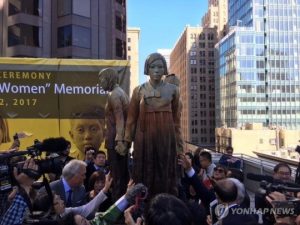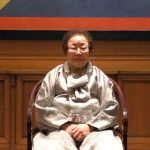 It has been 26 years since Kim Hak-sun, a Korean human rights activist, opened up in 1991 about the horrors she and an estimated 200,000 Asian women suffered throughout World War II. This includes women from Korea, China, the Philippines, Indonesia, Thailand as well as many other nations. A smaller population of European women were also reported to have been used as well. During Imperial Japan’s occupation and annexing of Asian countries as Japanese territories, the Imperial Japanese Army forced young women in these local populations of occupied territory into sexual slavery.
It has been 26 years since Kim Hak-sun, a Korean human rights activist, opened up in 1991 about the horrors she and an estimated 200,000 Asian women suffered throughout World War II. This includes women from Korea, China, the Philippines, Indonesia, Thailand as well as many other nations. A smaller population of European women were also reported to have been used as well. During Imperial Japan’s occupation and annexing of Asian countries as Japanese territories, the Imperial Japanese Army forced young women in these local populations of occupied territory into sexual slavery.
According to testimonies, they were either abducted from their homes or promised jobs in factories or restaurants once recruited. Around three fourths of the young women who were forcefully recruited died during the wartime from diseases, beatings, and other treatment. Among the surviving women, infertility rates were high due to the physical trauma from violent sexual abuse and sterilization treatments administered by military doctors during their time. Prominent voices of the movement include Kim Hak-sun who spoked of being rape 30-40 times every single day, day in and day out during her time as a sex slave for the Japanese military. Another prominent voice, Jan Ruff O’Herne, was one of several Dutch women taken and recruited by the Japanese military in the Dutch Indies. She described the selection process of being lined up and taken away from the prison camps they were held in to a brothel where she and the other girls were threatened to either submit or be killed.
To memorialize the suffering of these comfort women and thousands of others, the Comfort Women Justice Coalition unveiled a bronze statue on September 22nd, 2017 in San Francisco to the public. The statue, created by English-born sculptor Steven Whyte, depicts three young girls holding hands with each other. One Korean, one Chinese, and one Filipino, the three girls are dressed in their own respective traditional clothing as they stand together in solidarity. A fourth figure, a statue of Kim Hak-sun, looks upon them as the first ever comfort woman to come out revealing the wartime atrocities. The unveiling ceremony was well attended by multiple assemblymen, the consular general of Taiwan, former comfort woman Lee Yong-soo, and more as well as received blessings from the California state governor. The ceremony had many short speeches by many important attendees as well as the two women who spearheaded the project, former judges Lillian Sing and Julie Tang. They remarked at the ceremony how difficult the 2 year journey was to get the statue approved, made, and erected but also that it was nothing compared to the hardships the comfort women had faced.
 Among the speeches, there were many words said over the erecting of the statue, however the overarching themes were clear. This statue was to make sure history was to never be forgotten. To forget and erase a history is to doom yourself into repeating it. The statue was also to be representative of all women who have suffered under the sexual slavery system that is ever present in past and current wars. It is to say no more. Lee Yong-soo, affectionately named Grandma Lee, in a speech stressed that this is not an issue for Korea, China, or the Philippines but a universal human rights issue that affects everyone. She also said that this is also not about the money but receiving a sincere apology from Japan.
Among the speeches, there were many words said over the erecting of the statue, however the overarching themes were clear. This statue was to make sure history was to never be forgotten. To forget and erase a history is to doom yourself into repeating it. The statue was also to be representative of all women who have suffered under the sexual slavery system that is ever present in past and current wars. It is to say no more. Lee Yong-soo, affectionately named Grandma Lee, in a speech stressed that this is not an issue for Korea, China, or the Philippines but a universal human rights issue that affects everyone. She also said that this is also not about the money but receiving a sincere apology from Japan.
Japan has, over the years, been accused of playing-down their wartime atrocities during World War II or even flat out denying them. Current Prime Minister Shinzo Abe has even gone back and forth from relaying his sympathies to retracting them and denying the events ever occurred. The Japanese government often site a lack of evidence however countless testimonies have been told in multiple countries and in 2014, China recovered documents of what they claim is “ironclad proof” of Imperial Japan’s systematic and forceful recruitment of women as sexual slaves. An investigation was also conducted and concluded that the Japanese had destroyed many documents regarding this system in Korea towards the end of their occupation on the peninsula- however some had survived.
Predictably, the erection of the statue in San Francisco has received backlash from the Japanese government and threats from the mayor of Osaka, San Francisco’s sister city, Hirofumi Yoshimura in ending their sister relationship. The Japanese government has been very critical of the erecting of these statues as there are 40 in South Korea and 10 in the United States already as a memorial to comfort women to which the Japanese government argued that Japan shouldn’t be singled out for crimes that can be depressingly common in wartimes. In response to the San Francisco statue, they stated that the statue represents a very one-sided telling of history. However, the statue seems to not be going anywhere and has immense support from US lawmakers and citizens to keep it standing as a lasting message for future generations to come.
If you would like to learn more about Military Sexual Slavery by Japan during WWII, please check out VANK’s site below.
http://maywespeak.com
Written by: Lacey Bonner
Originally from the Washington DC metropolitan area, 3rd year student and Candidate for a Bachelor of Arts in Political Science and a Candidate for Bachelor of Arts in the Korean Language at the University of Hawaii at Mānoa, current exchange student for a 1-year period at Korea University and intern at VANK (Voluntary Agency Network of Korea)